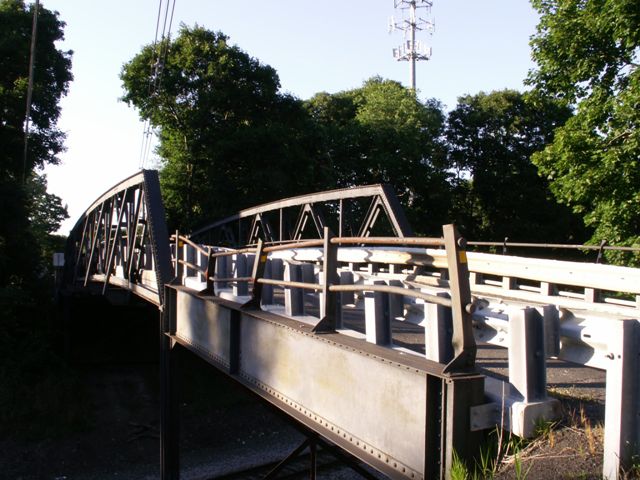We Recommend:
Bach Steel - Experts at historic truss bridge restoration.
BridgeHunter.com Phase 1 is released to the public! - Visit Now
Church Street Railroad Overpass

Primary Photographer(s): Nathan Holth and Rick McOmber
Bridge Documented: July 10, 2008
1985
81.0 Feet (24.7 Meters)
129.0 Feet (39.3 Meters)
13.8 Feet (4.21 Meters)
1 Main Span(s) and 2 Approach Span(s)
1050161

View Information About HSR Ratings
Bridge Documentation
This bridge's future is at risk!
Bridge Status: Slated for replacement as of 2019. Trusses might be preserved, to be "dismantled and salvaged for Hunterdon County" per county website.View Archived National Bridge Inventory Report - Has Additional Details and Evaluation
This bridge is unusual because the top and bottom chords are both equally curved and thus remain parallel. The curving was done to increase clearance for trains without increasing substructure and approach work/costs.
The bridge has been well maintained. Rather than demolish this historic bridge, Hunterdon County has signalized the one-lane bridge to ensure that this one-lane bridge with notable issues with seeing opposing traffic on the other side of the bridge remains safe for the traveling public. This solution represents an effective way to ensure that historic bridges do not compete with the requirement and expectation that public roadways be safe, reliable, and functional.
Information and Findings From New Jersey's Historic Bridge InventoryDiscussion of Bridge The 3-span bridge is composed of two short deck girder approach spans and a 6-panel riveted Warren with verticals pony truss main span built with curved parallel chords to increase clearance over the tracks. It is supported on concrete abutments and laced steel bents. Riveted outriggers are original. An expansion plate is located in the center of the span. Although there are no distinctive details, it is an unaltered example of a bridge type commonly used by the railroads since the 1890s. The structure is individually eligible for listing in the National Register under Criterion C. Discussion of Surrounding Area The bridge carries one lane of a lightly traveled 2-lane street over a single line of track of the Lehigh Valley Railroad now used as a Conrail freight line. It is located in a wooded village setting. Modern development is encroaching. Bridge Considered Historic By Survey: Yes |
![]()
Photo Galleries and Videos: Church Street Railroad Overpass
Bridge Photo-Documentation
Original / Full Size PhotosA collection of overview and detail photos. This gallery offers photos in the highest available resolution and file size in a touch-friendly popup viewer.
Alternatively, Browse Without Using Viewer
![]()
Bridge Photo-Documentation
Mobile Optimized PhotosA collection of overview and detail photos. This gallery features data-friendly, fast-loading photos in a touch-friendly popup viewer.
Alternatively, Browse Without Using Viewer
![]()
Maps and Links: Church Street Railroad Overpass
Coordinates (Latitude, Longitude):
Search For Additional Bridge Listings:
Bridgehunter.com: View listed bridges within 0.5 miles (0.8 kilometers) of this bridge.
Bridgehunter.com: View listed bridges within 10 miles (16 kilometers) of this bridge.
Additional Maps:
Google Streetview (If Available)
GeoHack (Additional Links and Coordinates)
Apple Maps (Via DuckDuckGo Search)
Apple Maps (Apple devices only)
Android: Open Location In Your Map or GPS App
Flickr Gallery (Find Nearby Photos)
Wikimedia Commons (Find Nearby Photos)
Directions Via Sygic For Android
Directions Via Sygic For iOS and Android Dolphin Browser
USGS National Map (United States Only)
Historical USGS Topo Maps (United States Only)
Historic Aerials (United States Only)
CalTopo Maps (United States Only)

